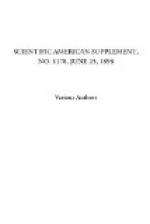The wise inventor will recognize the fact that the patent which he proposes to get is the deed to valuable property; that the object of the deed is not to permit him to enter upon the property, for he can do that without the deed, but that it is to keep strangers from entering upon the property; that he desires to enjoy his invention without unauthorized competition; that when the property begins to yield profit it will invite competition; that competitors may make machines worse than or as good as or better than his; and that he can get adequate protection only in a claim which would bar poorer as well as better machines embodying his invention. Briefly, then, all good claims for mechanism are combination claims; the fewer the elements recited, the stronger will the claim be; non-essential elements weaken or destroy the claim; the claim should not be considered satisfactory so long as a way is seen for the escape of the ingenious pirate.
COMBINATIONS AND AGGREGATIONS.
A given association of mechanical elements may be entirely new, but it does not follow that it forms a patentable association, for not all new things are patentable. If the new association is a combination, it is patentable, but if it is a mere aggregation, it is unpatentable. An association may be new and still all of its separate elements may be old, the act of invention lying in the fact that the elements have been so associated with relation to each other as to bring about an improved result, or an improved means for an old result. All new machines are, after all, composed of old elements. The law presupposes that the elements are old, and that the invention resides in the peculiar association of them. If we take a given mechanical element, recognized as having had a certain capacity, and if we then similarly take some other mechanical element and employ it only for its previously recognized capacity, and if we then add the third element for its recognized capacity, we have in the end only an association of three elements each performing its well recognized individual office, and the entire association performing only the sum of the recognized individual elements. Such an association is a mere aggregation, a mere adding together of elements, without making the sum of the results any greater in the association than it was in the individual elements. It is simply adding two to one and getting three as a result. An aggregation is unpatentable. As an illustration, a heavy marble statue of Jupiter is found in the parlor and difficult to move. Ordinary casters are put under its pedestal and it becomes easier to move. Modern anti-friction two-wheeled casters are substituted for the commoner casters, and the statue becomes still easier to move. Casters were never before associated with a statue of Jupiter. Here is a new association, but it is a mere aggregation. The statue of Jupiter has been unmodified by the presence of the casters, and the casters perform precisely the same under the statue of Jupiter that they did under the bedstead. There is no combined result, and there is no patentable combination.




